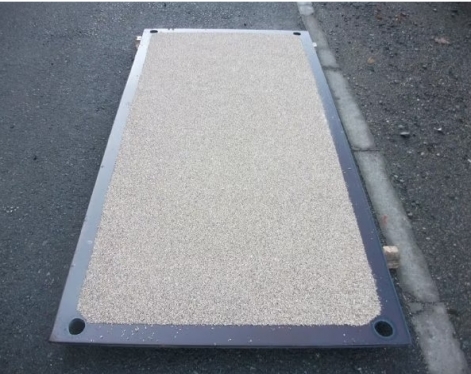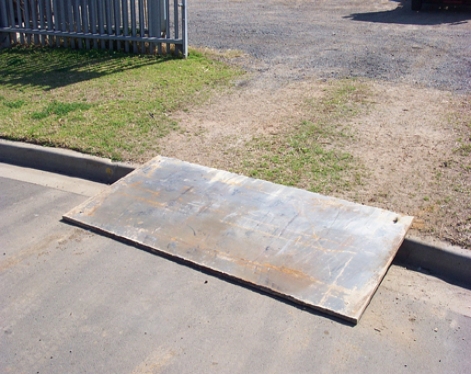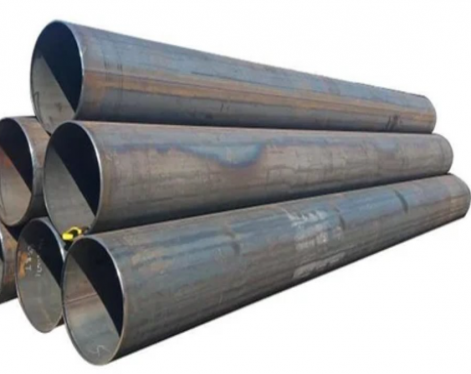Steel plates for roads, as an efficient, environmentally friendly, and economical construction material, have been widely applied and practiced in road engineering. Roadway plates are typically made from robust and durable materials, such as carbon steel plates, which possess excellent load-bearing capacity and compressive strength. Their primary function is to provide a solid and stable foundation for various construction sites. In road construction, the not-yet fully formed roadbed often cannot withstand the frequent traffic of heavy vehicles, and the laying of street plates effectively solves this problem. They evenly distribute the weight of vehicles, protect the fragile roadbed, ensure smooth traffic during construction, and reduce construction delays and cost increases caused by road damage.
In aggressive conditions, mild steel can degrade by about 10 microns per year, which would take roughly 50 years to degrade by 1 millimeter. Regular inspections and maintenance of the coating are crucial for sustained performance.
(1) Thickness
For steel plates, it's not necessarily the thicker the better. Greater thickness implies more weight, and the choice should be based on specific needs. Many projects have specific requirements for the use of steel plates. The thickness requirement for road steel plates ranges from 2.5 to 12mm, and the specific thickness to be used depends on the needs of the project site.
(2) Dimensions
In road steel plates, each 50mm difference represents a grade. The width of road steel plates typically ranges from 600 to 2200mm. Its impact resistance depends on the role it plays in the construction project, not necessarily on its thickness.
(3) Surface Quality
Steel plates are recycled, so when renting road steel plates, it is necessary to strictly review the quality of the plates. Check for any surface defects such as bubbles, protrusions, or cracks.
The thickness of the steel plates laid can vary depending on the roadbed project. Generally, the thicknesses are 16mm, 18mm, 20mm, and 22mm. Most roadbed projects require steel plates with a thickness between 16mm and 22mm.
Steel road plates, as a temporary or specialized road paving material, have the following notable features:
(1) Efficiency and Convenience
The modular design of road steel plates makes them easy to install and dismantle, which can greatly shorten the construction period and improve project efficiency.
(2) High Load-bearing Capacity
The steel material is sturdy and can withstand the traffic of heavy vehicles and equipment, ensuring the safety and stability of the road. On construction sites, especially under complex terrain conditions, the roadbed plates are particularly useful. They can span muddy and soft ground, providing a reliable working platform for large machinery such as cranes and excavators. With the support of roadbed plates, these machines can operate stably, improving construction efficiency and reducing safety hazards caused by unstable ground.
(3) Environmental Protection and Energy Saving
The recyclable steel material reduces the consumption of natural resources and the generation of construction waste, aligning with environmental protection concepts.
(4) Strong Adaptability
Road steel plates can be applied to road paving under different geological conditions and environmental requirements, showing a wide range of applicability.
(1) Temporary Road Paving:
At construction sites or temporary traffic arteries, road steel plates can quickly build temporary roads, facilitating construction vehicles and pedestrians.
(2) Repairing Damaged Road Surfaces:
For road damage caused by natural disasters or heavy vehicles, road steel plates can quickly fill potholes and restore road traffic capabilities.
(3) Special Occasion Road Paving:
In occasions requiring special anti-slip, anti-corrosion, radiation protection, and other specific needs, road steel plates can meet special requirements, ensuring the safety and stability of the road.
There are specific guidelines that must be followed when using a road plate to ensure safety and proper application at a construction site:
(1) Select dimensions based on traffic type and load.
(2) Overlap ensures a continuous and stable surface.
(3) Secure edges to prevent tripping hazards and water infiltration.
(4) Welding provides a strong joint for multiple plates.
(5) Countersinking adjusts for uneven terrain.
(6) Anti-skid coating enhances safety in wet or icy conditions.
(7) Edge markings improve visibility, especially at night.
(8) Warning signs alert road users to the presence of plates.
(9) Daily and weather-dependent uations prevent safety hazards.
(10) Winter notifications ensure road crews are aware for snowplowing or ice control.
(11) End-of-day inspections identify wear or damage requiring maintenance.
1.How long do steel road plates last?
In aggressive conditions, mild steel can degrade by about 10 microns per year, which would take roughly 50 years to degrade by 1 millimeter. Regular inspections and maintenance of the coating are crucial for sustained performance.
2.How to determine the quality of road steel plates?
(1) ThicknessFor steel plates, it's not necessarily the thicker the better. Greater thickness implies more weight, and the choice should be based on specific needs. Many projects have specific requirements for the use of steel plates. The thickness requirement for road steel plates ranges from 2.5 to 12mm, and the specific thickness to be used depends on the needs of the project site.
(2) Dimensions
In road steel plates, each 50mm difference represents a grade. The width of road steel plates typically ranges from 600 to 2200mm. Its impact resistance depends on the role it plays in the construction project, not necessarily on its thickness.
(3) Surface Quality
Steel plates are recycled, so when renting road steel plates, it is necessary to strictly review the quality of the plates. Check for any surface defects such as bubbles, protrusions, or cracks.

3.How thick are steel road plates?
The thickness of the steel plates laid can vary depending on the roadbed project. Generally, the thicknesses are 16mm, 18mm, 20mm, and 22mm. Most roadbed projects require steel plates with a thickness between 16mm and 22mm.
4.What are steel plates used for on roads?
Steel road plates, as a temporary or specialized road paving material, have the following notable features:(1) Efficiency and Convenience
The modular design of road steel plates makes them easy to install and dismantle, which can greatly shorten the construction period and improve project efficiency.
(2) High Load-bearing Capacity
The steel material is sturdy and can withstand the traffic of heavy vehicles and equipment, ensuring the safety and stability of the road. On construction sites, especially under complex terrain conditions, the roadbed plates are particularly useful. They can span muddy and soft ground, providing a reliable working platform for large machinery such as cranes and excavators. With the support of roadbed plates, these machines can operate stably, improving construction efficiency and reducing safety hazards caused by unstable ground.
(3) Environmental Protection and Energy Saving
The recyclable steel material reduces the consumption of natural resources and the generation of construction waste, aligning with environmental protection concepts.
(4) Strong Adaptability
Road steel plates can be applied to road paving under different geological conditions and environmental requirements, showing a wide range of applicability.

5.Applications of Steel Road Plates
(1) Temporary Road Paving:At construction sites or temporary traffic arteries, road steel plates can quickly build temporary roads, facilitating construction vehicles and pedestrians.
(2) Repairing Damaged Road Surfaces:
For road damage caused by natural disasters or heavy vehicles, road steel plates can quickly fill potholes and restore road traffic capabilities.
(3) Special Occasion Road Paving:
In occasions requiring special anti-slip, anti-corrosion, radiation protection, and other specific needs, road steel plates can meet special requirements, ensuring the safety and stability of the road.
6.Are there guidelines for using a road plate?
There are specific guidelines that must be followed when using a road plate to ensure safety and proper application at a construction site:(1) Select dimensions based on traffic type and load.
(2) Overlap ensures a continuous and stable surface.
(3) Secure edges to prevent tripping hazards and water infiltration.
(4) Welding provides a strong joint for multiple plates.
(5) Countersinking adjusts for uneven terrain.
(6) Anti-skid coating enhances safety in wet or icy conditions.
(7) Edge markings improve visibility, especially at night.
(8) Warning signs alert road users to the presence of plates.
(9) Daily and weather-dependent uations prevent safety hazards.
(10) Winter notifications ensure road crews are aware for snowplowing or ice control.
(11) End-of-day inspections identify wear or damage requiring maintenance.









